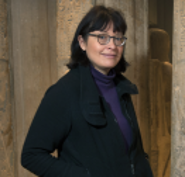
‘The ancient Egyptians were concerned with more than just death’
When we think about ancient Egypt, the first things that come to mind are usually mummies and sarcophagi. According to researcher and Rijksmuseum van Oudheden curator Lara Weiss, that impression is unjustified. She made an audio tour for the Rijksmuseum van Oudheden that focuses on living Egyptians and their relationship with death and the dead.

‘If you invest that much time and effort in being able to live on in the afterlife, that’s a clear sign you have a real appreciation for life,’ says Weiss. ‘The fact that we always talk about death in ancient Egypt is mostly due to how the collections came into being.’
Pragmatic
Weiss would rather focus on the lives of the ancient Egyptians, but even in her case, death is never far away. Her VIDI project, The Walking Dead at Saqqara, is centred around the life and rituals of the Egyptian City of the Dead, Saqqara. ‘Because of movies like The Mummy, there’s a misconception that it’s very spooky or strange there, but the ancient Egyptians were actually very pragmatic. They’d take a “receipt” to their tomb to ensure that payment for their crossing to the afterlife would go smoothly or as proof that their servants were paid for their hard work. This “receipt” wasn’t written on a piece of papyrus, but instead was permanently carved into one of the walls of the burial chamber.’
These kinds of depictions enable modern-day researchers to map out what a funeral of these people used to look like. ‘Most of the deceased have a depiction of a procession of grave goods entering the tomb, for example,’ Weiss further explains, ‘but you can see the most differences in what kind of details have been chosen to depict. One only depicts anonymous people, while the other shows his wife or servants. The choice who is represented says something about the person who made that choice (i.e. the tomb owner), but also about his networks and social environment.’
Extra layer
Weiss translated such findings into an audio tour for the Rijksmuseum van Oudheden. ‘A VIDI project and an audio tour obviously have wildly different target audiences,’ she says. ‘An audio tour requires a lot more basic information than an academic publication, and I made an effort to present a different viewpoint on the Ancient Egyptian museum collection than usual.’
That is why the tour does not pause in front of the mummies. Instead, the listener is made to stop in front of pieces that connect the dead with the living, such as a letter to the dead and a Ba-bird, which symbolises the soul of the deceased. The Ba can leave the tomb during the day and visit his relatives, for example. ‘An audio tour is a wonderful way to challenge visitors to look at the small details of the objects. Who do you see? What are they doing? What is their relationship? I can’t present all the research I’ve done at the museum, but I hope that people realise that the deceased have made choices that are unique to each individual. Around the time such a tomb was being built, you’d still have about ten, twenty years to live. You could make it more and more beautiful, similar to how people buy and decorate their homes today. It’s a form of expression of a person’s life and identity, and sometimes maybe also a way to compete with your neighbours.’
The audio tour is available free of charge at the Rijksmuseum van Oudheden. The tour is available in Dutch, English and Arabic.
